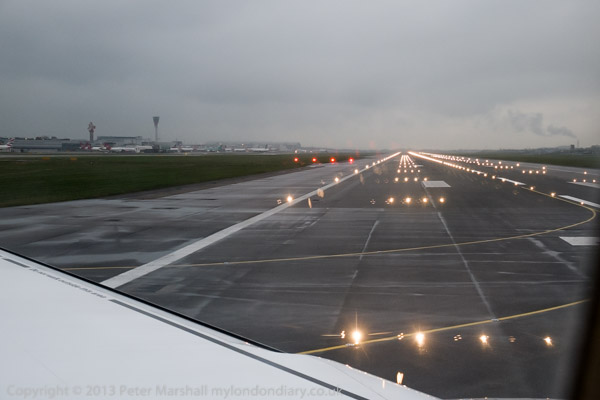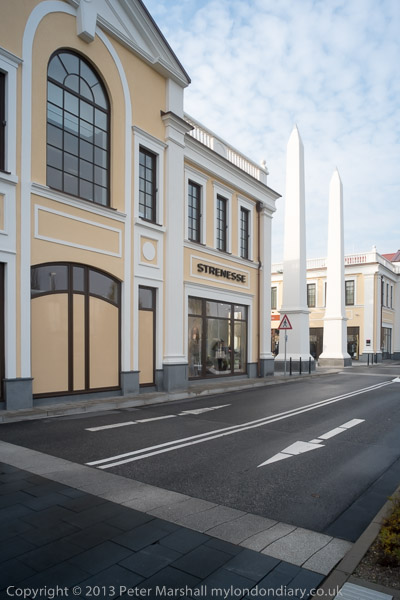
Moving on to the runway at Heathrow Fuji-X 18-55mm
For my trip to Germany last month I took just one camera – the Fuji X-E1 – and three lenses, the Fuji-X 18-55mm (27-83mm equiv), the Voigtlander 15mm (22.5mm eq) and the full-area fisheye Samyang 8mm. Along with a few 16Gb cards and four spare batteries and the charger.
Mostly I wanted to use a camera to photograph some family events, and the X-E1 is not a bad camera for discrete use; fairly small and quiet enough in quiet mode not to be noticeable in a room with a normal level of conversation.
The 8mm and 15mm don’t have image stabilisation, but I didn’t miss it. Possibly camera shake was lessened by the liberal application of the local beer to the photographer, along with the odd glass of Hugo, a drink I find just a little too sweet, combining prosecco, lime, mint and elderflower syrup. And there was also a rather powerful vodka-based concoction containing yoghurt. Together in moderate quantities I think these give about a two-stop advantage! But the 18-55mm has optical image stabilisation, and perhaps a few images at the longer end were sharper for it.

8mm Samyang
The Samyang is a remarkable lens, and the fact that it is a manual lens hardly matters at all on the X-E1, where there is seldom any need to focus. In fact I’d prefer to have a lock that stopped me focussing, as although for nearly everything you can leave the lens set to infinity it is possible to focus down to 1 ft, at which point things more distant can get slightly unsharp.
One very small problem with the lens is that the camera doesn’t know the aperture in use, though of course it gives the correct exposure despite this. It’s just a little of a shock to look at the EXIF data and find you were apparently taking pictures at f1!
Most of the images with the Samyang – such as that above – were interiors in normal room lighting and I was working at its full aperture of f2.8. Even wide open it is already pretty sharp across the frame. Any lack of sharpness in these images was either from accidental shifting of the focus, subject or camera movement. And with exposures sometimes down to around 1/20s, subject movement was a real problem.
And as you can see the Samyang does give a different view. Although there is some of the normal curvature you expect from a fisheye – perhaps most obvious in the lines between walls and ceiling, the Samyang employs a different mapping to the usual equisolid projection in fisheyes. This is the stereographic projection, which results in less distortion of objects at the edges and corners of the frame, giving the images a far more natural look. The figure at bottom left would have been noticeable distorted in a normal fisheye image, but looks almost normal here.
With other fisheyes, such as the 10.5 Nikon I’m rather fond of, its often essential to use software such as Fisheye-Hemi to give a more usable result, but correction is far less necessary with the Samyang. So you get the extreme angle without the extreme distortion. A small down-side to this is that if you do want to ‘correct’, Fish-Eye Hemi doesn’t quite get it right, though it does still generally do better than most other software I’ve tried*.

15mm Voigtlander
The Voigtlander 15mm is a great lens, but not great in poor light with its maximum aperture of f4.5 but it is relatively cheap and beautifully small. One problem is that it has a bulging front element that makes fitting a filter for protection impossible. Mine is in the old screw thread Leica mount, but you can now get the same lens in a Leica M mount, and for under £400 if you look around, a real snip compared with Leica prices. I have it fitted with a Leica M adapter and that then goes into a Fuji X adapter. The 15mm also seldom needs focussing and the scale is generally accurate enough. I used this lens for years on Leica M and compatible bodies and its performance is fine. If there is any distortion it is never noticeable. Again for the EXIF everything appears as f1.
The 18-55mm is an f2.8 lens at the wide end, but by the time you zoom out to 55mm it is only f4, which rather reduces its utility in low light. Otherwise there was really nothing to complain about.

18-55mm Fuji-X and some laser lighting
The camera itself performed pretty adequately, particularly in low light, where most of the time I was working at ISO 3200. Increasing the Luminance noise reduction in Lightroom from my normal 27 to around 50 made the results much smoother (keeping the detail setting around my normal 20 and contrast 2.) There was significantly more colour noise than at ISO 640, but it disappeared with a ‘color’ noise reduction setting of 25.
I had no problems with the digital viewfinder in low light, but in bright conditions it was sometimes impossible to see detail. It was good enough to see which way you were pointing the camera and the limits of the frame, but hardly to see what the pictures would look like.
I really do wish Fuji could find a solution to the deep sleep mode which this camera descends into after switching itself off to save the battery. The quickest way to wake it up seems to be to switch the camera off and on again and wait the second or two for it to come back to life. By which time the picture has often flown.
Battery life is a problem too. The day we went on the most interesting visit I’d rushed out thinking we would be coming back before setting out on the main trip and I would pick up my camera bag before going out for the day. We didn’t and although I’d taken the camera, the battery was dead after the first picture or two. The camera needs a better battery level indicator too, as you only get the warning when it’s already virtually dead. Its generally necessary to take at least 3 batteries to be sure of a day’s work, and four if you are going to be busy. The batteries are supposed to last around 300 pictures, but its easy to run them down faster if you are showing people pictures etc.
Photographing at family parties as I was doing quite a lot of the while, the more interesting moments are often when people are moving. I hadn’t bothered to take a separate flash, and it would have destroyed the mood at times to have used one. I did make a few images with the small unit built into the camera at a more public event when people were dancing, but wasn’t too happy with it. Its really something for emergency use only, though better than many built in flashes. Of course the flash isn’t much use with the fisheye, putting hardly any light into the corners, but it covers the 15mm surprisingly well. There is a brighter central area, but it is relatively easy to even out in Lightroom if you don’t want something of a spotlit effect.
A few minor niggles aside, I was impressed by the quality of the results, and was glad to have only a fairly light weight to carry around. The 18-55 zoom feels a little large on the camera, and for general use I think I might prefer to have perhaps a couple of prime lenses, perhaps the two pancakes (18mm and 27mm ), possibly adding the longer 55-200 zoom when a long lens was essential. Most days I’d prefer a second body too. If you are used to carting Nikons they are pretty light.
In further posts I’ll look more at the other pictures I took in Germany, and perhaps also about making use of the video mode on the Fuji X-E1.
*I think you could possibly use the free Panorama Tools if you could work out how to do it. I’ve got the best results by taking the image into PtGui and converting it to Mercator projection, trimming the output to give a rectangle and then resizing that to 3:2 aspect ratio, but that seems a lot of work and the difference is really quite small.
______________________________________________________
My London Diary : Buildings of London : River Lea/Lee Valley : London’s Industrial Heritage
All photographs on this and my other sites, unless otherwise stated, are taken by and copyright of Peter Marshall, and are available for reproduction or can be bought as prints.
To order prints or reproduce images
________________________________________________________